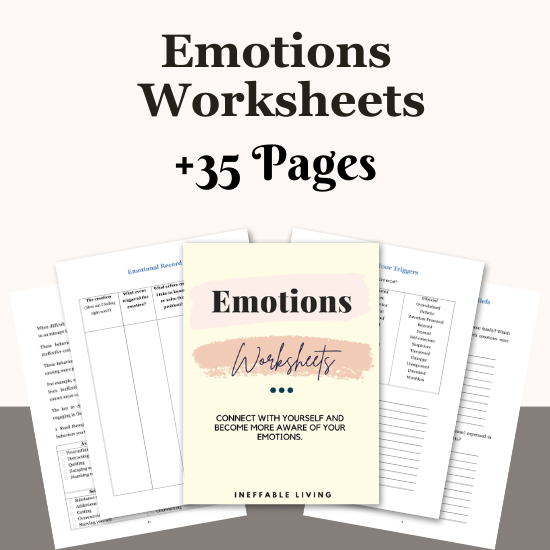Emotions are an essential part of our human experience, yet many of us struggle to understand and manage them effectively.
This often leads to impulsive reactions and behaviors that can disrupt our lives.
Learning to identify and name our emotions is a powerful tool that can help us gain control and improve our emotional well-being.
This blog post explores the concept of “Name It to Tame It,” offering insights and practical steps to better understand and process your emotions.
What is “Name It to Tame It”?
“Name It to Tame It” is a concept that suggests labeling our emotions can significantly reduce their intensity.
The idea is simple: when we give a name to what we’re feeling, we start to process it more logically, engaging the part of our brain responsible for reasoning and problem-solving.
This helps to calm the emotional storm and provides clarity.
Related: The Big List of Emotions
The Science Behind Naming Emotions
Research shows that naming our emotions activates the prefrontal cortex—the rational part of our brain. (source)
This process helps us regulate our emotions by connecting the emotional and rational parts of our brain.
When we name our emotions, we engage our thinking brain, which helps us process and manage our feelings more effectively.
Practical Steps to Name and Tame Emotions
1. Pay Attention to Your Feelings
Start by noticing what you’re feeling.
This requires mindfulness and self-awareness.
Regularly check in with yourself to identify your emotions.
2. Use Emotion Words
Use specific words to describe your emotions.
Instead of saying, “I feel bad,” try saying, “I feel disappointed,” “I feel frustrated,” or “I feel anxious.”
The more specific you are, the better.
3. Journal Your Emotions
Writing down your emotions can help you process them.
Keeping a journal allows you to reflect on your feelings and gain insights.
Related: Top 21 Emotional Writing Prompts To Process Emotions
4. Share Your Feelings
Talk to someone you trust about your emotions.
Sharing your feelings can provide support and additional perspectives.
5. Use “I Feel” Statements
Practice using “I feel” statements to express your emotions.
For example, “I feel angry because I was interrupted during the meeting.”
This helps in expressing emotions constructively.
6. Set Goals
Identify specific goals related to managing your emotions.
For instance, aim to recognize and name your emotions daily or practice mindfulness to improve emotional awareness.
Related: Best 35 Journal Prompts for Releasing Difficult Emotions
Common Pitfalls in Naming Emotions
While naming emotions is powerful, there are common pitfalls to avoid:
1. Confusing Thoughts with Emotions: Statements like “I feel like the world is against me” are thoughts, not emotions. Ensure that you use emotion words such as “I feel sad,” “I feel angry,” or “I feel scared.”
2. Overgeneralizing: Avoid vague descriptions like “I feel bad.” Be specific about your emotions to gain more clarity and control.
3. Identifying with Emotions: Instead of saying, “I am sad,” say, “I feel sad.” This subtle shift helps you see emotions as experiences rather than identity traits.
Related: How To Feel Your Feelings? Top 9 Difficult Emotions To Cope With In Healthy Ways
Examples of Naming Emotions in Daily Life
Consider the following scenarios where naming emotions can be beneficial:
1. After a Long Day at Work: You come home feeling exhausted and irritable. Instead of snapping at your family, take a moment to identify your emotions. “I feel tired and stressed because of the meeting today.”
2. Facing Conflict: During a disagreement with a friend, you feel hurt and angry. Instead of lashing out, name your emotions. “I feel hurt because I feel misunderstood.”
3. Experiencing Disappointment: You didn’t get the promotion you wanted and feel a mix of emotions. Identify and name them: “I feel disappointed and frustrated.”
Related: How To Feel Your Feelings? Top 9 Difficult Emotions To Cope With In Healthy Ways
Building an Emotional Vocabulary
Enhancing your emotional vocabulary can improve your ability to name and tame emotions.
Use tools like emotion charts or thesauruses to find precise words for your feelings.
The more specific you are, the better you’ll be able to manage your emotions.
Exercises to Practice Naming Emotions
1. Emotion Tracking
Keep a daily log of your emotions.
Note the events that trigger them and the specific words to describe your feelings.
Reflect on patterns and insights.
2. Mindfulness Meditation
Practice mindfulness to increase your awareness of emotions.
Spend a few minutes each day focusing on your breath and observing your feelings without judgment.
Related: Best 6 Mindfulness Exercises For Beginners (+FREE Resources)
3. Emotion Word Lists
Create a list of emotion words and review it regularly.
Practice using these words to describe your feelings accurately.
4. Role-Playing
Engage in role-playing exercises with a friend or therapist.
Practice naming and expressing emotions in various scenarios to build your skills.

Conclusion
Naming your emotions is a simple yet powerful tool for emotional well-being.
By identifying and naming your feelings, you gain clarity, control, and the ability to communicate effectively.
This practice can transform your emotional life, helping you build resilience and improve your relationships.
Start today by paying attention to your emotions, using specific emotion words, and practicing mindfulness.
With these steps, you’ll be on your way to a healthier and happier life.



